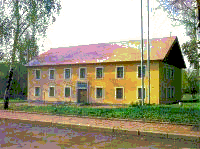The Truth of Hermann Graf's Activities in Soviet Captivity

POW barrack at Soviet POW Camp No. 27, Krasnogorsk: Hermann Graf's "home" between 1945 and 1949.
Hermann Graf spent many years in Soviet captivity. Much has been said and written about Graf's alleged cooperation with the Soviets. This will be analyzed in detail in the book "Graf & Grislawski".
The authors have carried out a painstaking research into various Russian archives in order to uncover the truth of Hermann Graf's activities in Soviet captivity. The aim of this research has not been to defend or accuse anyone - only to find the truth. Among other things, the authors have gained access to an extensive material from Russian POW archives - including Hermann Graf's entire, and extensive, POW file. This file has been hidden in a Russian archive until recently (December 2001), and hitherto it has not been seen by any other researchers. Finally, it is possible to uncover the full truth of Hermann Graf's activities in captivity. And not only that - this extensive file also contained many important documents dealing with Graf's career as a fighter pilot; documents which Graf brought with him when he was captured.
Moreover, each prison camp where Graf was held, has been investigated thoroughly. The old POW Camp 27 at Krasnogorsk was visited by one of the authors, who took the photo above. Today this building holds the Memorial Museum of German Anti-Fascists. This is the only museum in Russia that deals with POWs of World War II and the Great Patriotic War. The camp was located in the town of Krasnogorsk between 1942 and 1950. The Museum exposition and funds contain rare materiel and documents reflecting to different aspects of life of the foreign prisoners of war in the USSR in the period of 1941 through 1956, including official documents concerning the captivity, personal effects and identity papers, articles of everyday life, handiworks made by the prisoners, etc. The Museum has an electronic database on the foreign prisoners of war kept in Camp No. 27.
Hermann Graf was transferred from Camp 150 at Gryazovets on 8 December 1945, to Camp 27 at Krasnogorsk, where he arrived on 9 December 1945. Camp 27 was directly subordinated to the NKVD. This Camp existed between 1942 and 1950, and it was one of the largest Soviet Special POW camps. It also was an important interrogation center. Many of the "special POWs" who were due to be sent to the Lubyanka prison in Moscow passed through Camp 27 for thorough interrogation by representatives of the NKVD. In total, 60,000 prisoners passed through Camp 27.
On 25 December 1949, Hermann Graf was transferred from Camp No. 27 to Transition Camp No. 69 in Frankfurt-Oder in East Germany.
It was during Graf's stay at Camp No. 27 in Krasnogorsk that he became subject for accusations of collaboration from other German POWs in another POW camp.
In which extent Graf - and other POWs - cooperated with their captors, is evident from the POW files. Some of the material that is presented in the book "Graf & Grislawski" may come as a surprise to some people.
More by Christer Bergström -
the detailed history of the air war on the Eastern Front 1941 - 1945:
Black Cross/Red Star: Air War Over the Eastern Front
© Christer Bergström, Vlad Antipov 2003